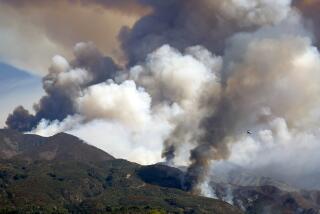Fires Threaten Homes, Force Evacuations
- Share via
Fires in San Bernardino National Forest and Glendora charred thousands of acres, threatened homes and forced evacuations Sunday as Southern California firefighters prepared for what could be the most devastating wildfire period in recent years.
At least 10,000 acres were burning in a broad swatch of foothills and rugged mountain terrain in separate fires that authorities said were fanned by shifting winds in the San Bernardino and San Jacinto mountain ranges.
A 6,000-acre blaze in the Willow Creek area northeast of Lake Arrowhead theatened homes in the resort town and the community of Cedar Glen, said Melody Lardner, a spokeswoman for the U.S. Forest Service.
The fire, which was 10% contained, was described as very active, spreading north toward the Apple Valley and Lucerne Valley. Authorities determined that the blaze erupted from an untended campfire in the back-country behind Lake Arrowhead. Two firefighters, suffering from asthma and heat exhaustion, were treated for minor injuries.
Residents of Lake Arrowhead, a picturesque village of million-dollar homes, were reported to be nervously monitoring the situation.
Pasadena resident Joe Ehring said that his sister, Elaine Peconi, who lives in the area, was contacted by firefighters and told to prepare to flee.
“She said she was going to bring the dogs and stay down here,” said Ehring. “Right now she’s gathering pictures she doesn’t want to lose. It’s a rural enclave with narrow, steep roads. I’m sure it’s pretty hard to get equipment in there.”
Another fire erupted Sunday about 2:30 p.m. near Highway 39 and East Fork Road in Angeles National Forest, north of Glendora. About 250 acres were burning with no estimate of when the blaze might be contained.
No homes were threatened but fire officials evacuated the rugged terrain north of Highway 39, an area popular with recreational shooters, said U.S. Forest Service spokeswoman Gail Wright. The fire was first spotted by a forestry worker on patrol. No cause has been determined, Wright said.
Elsewhere, a blaze in the San Jacinto Mountains charred more than 2,500 acres near the junction of Highways 74 and 243, just east of Mountain Center in Riverside County, said Lardner.
The blaze was reported at 2:16 p.m. and forced the evacuation of Baldy Ranch Trailer Park and the Lake Hemet Campground. Residents and campers fled to two Red Cross evacuation centers in nearby Idyllwild and Hemet. The fire was about 10% contained Sunday, and the cause was under investigation.
A second fire in the San Jacinto range that began Saturday near Highway 243 and Twin Pines Road burned more than 1,500 acres and destroyed four vacant structures. The fire was 50% contained Sunday, and residents of the Twin Pines community who had been evacuated were allowed to go back to their homes, said Iral Evans, a spokesman for the California Department of Forestry. The cause of this fire has not been determined.
Meanwhile, a blaze near Mt. Baldy was fully contained Sunday, officials said. The fire, which burned about 600 acres, started Wednesday morning when a car went over the side of the road and burst into flames. Three people in in the vehicle suffered minor injuries.
In the Antelope Valley, firefighters were still trying to gain the upper hand on a brush fire that by late Sunday had burned more than 250 acres and damaged a home.
Fanned by 10- to 15-mph winds, the blaze broke out about 3:45 p.m. in the 5200 block of Shannon Valley Road and destroyed four sheds, said Los Angeles County fire spokesman Edward Osorio.
As many as 170 firefighters battled the fire in thick brush with the help of three water-dropping helicopters, Osorio said. As of 8 p.m. Sunday, the fire was still burning out of control.
The widespread fire activity provided an early jolt for Los Angeles city and county firefighters who had expected a busy brush fire season, which officially begins Wednesday.
The culprit: El Nino. Its winter storms nearly two years ago dumped rain across the region, causing increased plant growth that is now drying out under the hot summer sun, fire officials said.
“If this weather keeps up, we will have an extremely dangerous situation,” said Fire Capt. Paul Quagliata, head of the city’s brush clearance unit.
“There is so much more dead, dry fuel out there to feed a fire, and that’s what makes it such a volatile problem this year,” he said. “Put a wind behind it and it becomes a major fire in no time at all. If we were to get a fire, it is going to be a doozy.”
Predictions about fire danger are based on the amount of moisture in ground vegetation, called fuel moisture levels, officials said. The less moisture in plants, the more flammable they become.
Fuel moisture levels are below normal this season, according to county Fire Department forestry division records. Officials said that firefighters check fuel moisture levels in brush at 18 sites across the county every two weeks.
In the Santa Monica Mountains, fuel moisture levels in plants stand at 73%, down slightly from the normal 76%. Plant life in the Castaic/Saugus mountain region contains 68% moisture, down from its 73% normal reading. And in the Malibu hills, where the average moisture content in plants is 73%, moisture levels range from 68% to 75%.
Firefighters also rely on weather forecasts to determine fire danger during brush fire season, which runs through Dec. 31.
Forecasters predict cooler and drier weather this winter with near normal precipitation and temperatures slightly below normal.
“A dry and cool winter would increase the chance for brush fires,” said Guy Pearson, a meteorologist with WeatherData Inc., which provides forecast information to The Times.
Thick brush, dry weather and gusty winds are all elements that feed brush fires, officials said.
This year, firefighters have added several new weapons--including foam, gel, compact firetrucks and fireproof pumper trucks--to their arsenal. The newer technology will be used along with traditional water-dropping airplanes and helicopters.
To combat blazes, Los Angeles County fire officials have contracted with Canadian fire companies to deploy two fixed-wing aircraft to drop water on brush fires. Each airplane, called a SuperScooperCQ, can drop 1,600 gallons of water at a time.
In addition, city firefighters would have a helicopter capable of dropping 2,600 gallons of water and six water-dropping helicopters, each capable of releasing 320 gallons at a time, officials said.
Still, fire officials say property owners are the first line of defense in battling brush fires, especially those in hillside communities such as Bel-Air, Westwood, Baldwin Hills, Ladera Heights, Mt. Washington, El Sereno and the San Fernando Valley communities south of Ventura Boulevard, north of Rinaldi Street and along the Foothill Freeway.
“If we can get people to maintain a space between the brush and their homes, we can get a working crew in there to extinguish the fire,” Quagliata said. “Without the adequate clearance, we don’t stand a chance of saving the house.”
County and city fire departments require a clearance of 200 feet between structures and vegetation and 10 feet from any roads, officials said.
So far, city fire inspectors have completed 180,000 inspections and issued 31,000 notices of noncompliance, officials said. Of that number, all but 8,000 have complied with the law.
Although the threat of wildfire is minimal in low-lying communities, fire officials recommend that all property owners cut dead branches hanging over roofs, trim tree limbs within 10 feet of chimneys, screen chimneys with half-inch wire mesh to keep sparks from flying, clean gutters and eaves, and consider buying a gas-powered pump and fire hose so they can use pool water to fight fires.
(BEGIN TEXT OF INFOBOX / INFOGRAPHIC)
(B4, San Fernando Valley Edition), Protecting Your Home
Los Angeles city and county firefighters are preparing for what could be the most devastating wildfire period in recent years due to increased plant growth in mountain communities caused by El Nino storms nearly two years ago. Brush clearance is one among several precautions homeowners can take to reduce the danger.
Clearing Your Land
Although it’s one of the best ways to prevent major fires--or simply reduce the chance that a fire will engulf a small area--many property owners aren’t obeying the city’s brush ordinance that requires brush and grass to be cleared within 200 feet of any structure and 10 feet of a roadway.
The expense of clearing brush is passed on to the property owner plus a $314 administrative fee. There is no fine or other penalty, said Capt. Paul Quagliata, commander of the city fire Department’s Brush Clearance unit.
Information on Clearing:
Valley Fire Department:
(818) 756-8561
City Fire Public Information:
(213) 485-5162
Los Angeles County Brush Clearance:
(909) 622-8342
*
Sources: Los Angeles City Fire Department; Los Angeles County Fire Department
More to Read
Sign up for Essential California
The most important California stories and recommendations in your inbox every morning.
You may occasionally receive promotional content from the Los Angeles Times.









